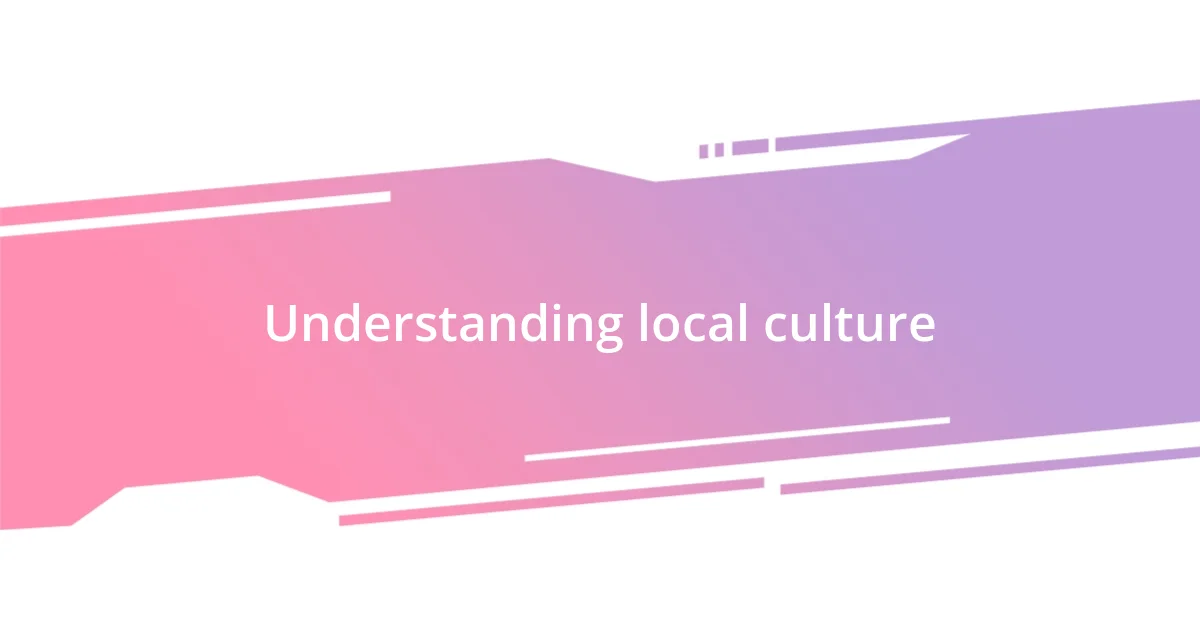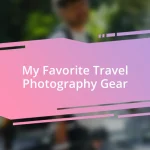Key takeaways:
- Engaging with local communities uncovers deep stories and connections, emphasizing the importance of vulnerability and shared experiences in photography.
- Building rapport with subjects through genuine conversation and patience enhances authenticity, allowing for more meaningful interactions and moments to be captured.
- Ethical considerations, such as consent and portrayal, are crucial in local photography; it’s essential to honor the dignity of subjects while balancing artistic expression with moral responsibility.

What shooting locals taught me
Shooting locals has truly opened my eyes to the depth of stories waiting to be told in my own backyard. I remember a day when I approached a group of elderly fishermen by the docks. Their laughter mixed with tales of the sea revealed not just history, but a bond forged through shared experiences—how many such connections have we overlooked in our daily lives?
Through these encounters, I learned the beauty of vulnerability in storytelling. One time, while capturing a mother and her children playing at the park, I noticed her quiet strength as she managed an unruly toddler. It made me wonder: how often do we pause to appreciate the small victories in our communities, the moments that define us?
Every shoot teaches me that photography is more than just images; it’s about capturing humanity. While documenting a local festival, I felt a rush of joy reflecting the vibrant energy of the crowd. Isn’t it fascinating how a single photograph can encapsulate a feeling, connecting strangers through shared moments? Each click reminds me that we’re all part of a larger narrative.

Understanding local culture
Understanding local culture is an enriching journey that I find deeply rewarding. I recall a chilly evening when I stumbled upon a neighborhood potluck. The warmth radiating from shared dishes told stories of ancestry and traditions. It struck me how food acts as a universal language, bridging gaps between diverse communities with every bite. Have you ever tasted a dish that instantly transported you to a different place or time? That’s the power of local culture.
Engaging with locals has shown me that every culture has unique nuances. I was covering a community parade once, and I noticed how different generations interacted, blending modern expressions with traditional attire. It’s like watching a living timeline unfold. These moments remind me that culture isn’t a static entity; it evolves while remaining rooted in its history. Don’t you find that fascinating? Just like a photograph—each frame capturing both the present and the echoes of the past.
My experiences have taught me that understanding local culture goes beyond mere observation; it’s about immersion. A few months ago, while photographing a local artisans’ market, I had the chance to converse with a sculptor who shared her creative process. Her passion revealed not only her artistry but also how her work reflects the struggles and aspirations of our community. It made me appreciate the emotional investments behind each piece and how they tell a collective story.
| Aspect | Observation |
|---|---|
| Food Culture | A shared meal can convey deep cultural heritage. |
| Generational Connections | Interactions highlight the dynamic nature of culture. |
| Artistry and Community | Creativity showcases communal struggles and aspirations. |

Techniques for capturing authentic moments
Capturing authentic moments requires being present and aware of your surroundings. I find that slowing down and truly observing what’s happening around me can reveal unexpected snapshots of life. There was a rainy afternoon at a local café where I noticed an elderly couple sharing a single umbrella. The way they leaned in to whisper to each other, despite the pouring rain, felt like a scene from a vintage love story. Moments like these remind me how love and companionship endure, and they’re often best captured when you least expect it.
To enhance your ability to capture authenticity, consider these techniques:
- Embrace natural light: Soft, diffused light can create a warm atmosphere, perfect for intimate moments.
- Use a longer lens: This allows you to capture candid moments from a distance, so subjects feel less aware of the camera.
- Pay attention to body language: Expressions and gestures often tell a deeper story than posed shots.
- Be patient and observant: Sometimes the best moments happen when you least expect them, so allow yourself time to absorb the environment.
- Engage in conversation: A simple chat can put subjects at ease and elicit genuine expressions.
On my last outing, I photographed a bustling farmers’ market brimming with energy. Amidst the colorful stalls, I caught a young boy, his face lighting up as he tasted a juicy strawberry. His delight was pure and unfiltered, a beautiful contrast to the grown-ups busy negotiating prices. I believe these spontaneous outbursts of joy are the essence of humanity, and capturing them requires both keen observation and a willingness to be vulnerable myself as a photographer.

Building rapport with local subjects
Building rapport with local subjects is a vital aspect of my photography journey. Recently, I attended a local festival and decided to approach a group of artists setting up their booths. I began by simply expressing genuine interest in their work, asking questions about their creative process. It was incredible to witness how a small compliment on their art transformed the atmosphere. Have you ever seen how a simple acknowledgment can break down barriers? I felt their walls lower, and suddenly we were engrossed in an enthusiastic discussion, opening doors to authentic moments.
One thing I’ve observed is that sharing a bit of myself often encourages others to open up. On a chilly morning at a neighborhood market, I shared a story about my first art show while chatting with a vendor. As I recounted my nervousness, I noticed her nodding knowingly, her own stories bubbling to the surface. This exchange built a connection that went beyond mere interaction. I realized that sharing vulnerabilities can create a space where both parties feel free to express themselves. Doesn’t it feel refreshing to connect over shared human experiences?
Another lesson I learned is the power of patience when building rapport. Early in my career, I joined a local drum circle. My initial attempts to jump right in felt forced, and I quickly learned that genuine connection takes time. After quietly observing for a few sessions, I finally felt comfortable enough to participate. It was then that a mutual understanding bloss—my hesitation resonated with others, and soon we were sharing our thoughts and experiences while embracing the rhythm together. Looking back, I see how important that initial period of simply being present was to forming those real relationships. What if we all allowed ourselves the time to let connections happen naturally?

Ethical considerations in local photography
Engaging in local photography raises several ethical considerations, especially regarding consent and respect for privacy. I remember an instance where I photographed a street musician immersed in his craft. As I captured the moment, I became acutely aware of how vulnerable he was in that setting. It made me reflect: is taking a photograph without consent disrespectful? The answer, I believe, often depends on the context and the relationship established with the subject.
Beyond consent, I always think about the impact my photos can have on local communities. During a recent trip to a neighborhood festival, I photographed a group of teenagers enjoying themselves. Later, I learned that some felt uncomfortable with those images being shared online, fearing they could be misrepresented. This experience taught me to be a steward of my subjects’ dignity. How can we be conscientious photographers while still telling the stories we are passionate about? I’ve found that maintaining open dialogue with subjects not only builds trust but also ensures their voices are honored.
Lastly, I recognize the fine line between artistic expression and exploitation. While attempting to portray the beauty of my local community, I encountered a family living in poverty. Capturing their struggle in the name of art felt exploitative to me. I opted for a different approach, focusing on their resilience through positive interactions in the community instead. In my view, it’s essential to portray those stories with compassion, ensuring that, as photographers, we elevate rather than objectify. This approach has profoundly shaped the way I engage with my subjects. Do you think it’s possible to balance artistic freedom with moral responsibility? I certainly believe it can be done with care and intent.

Sharing your work and experiences
When it comes to sharing my work, I’ve found that transparency can enhance connections with my audience. I once shared a behind-the-scenes look at my creative process on social media, revealing the challenges and joys of capturing local moments. The feedback was overwhelming—people resonated with my struggles, and it sparked a conversation that made me feel more connected to my followers than ever. Isn’t it amazing how showing our true selves can invite others into our world?
Another experience that stands out was when I curated an online gallery featuring portraits from my latest local shoot. I took the time to include storytellers’ quotes alongside their images. The warmth in their words was contagious, and viewers felt a deeper connection to each photograph. This practice reminded me that it’s not just about the visuals. How often do we overlook the narratives behind the images we create?
Sharing experiences isn’t limited to just online platforms. I recall attending a community event where I displayed my work and engaged with locals face-to-face. Their reactions and conversations brought the photos to life in ways I couldn’t have imagined. One person even shared how a picture I took reminded them of their childhood. This interaction reinforced my belief that sharing our work is a two-way street—a continual give-and-take that fuels our creative journey. How does sharing your work affect your creative process?












